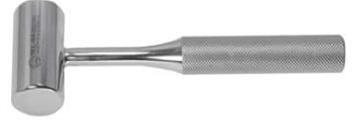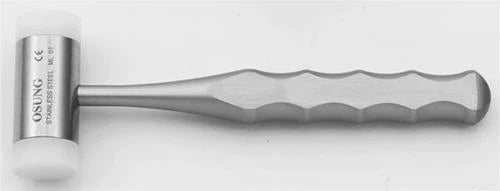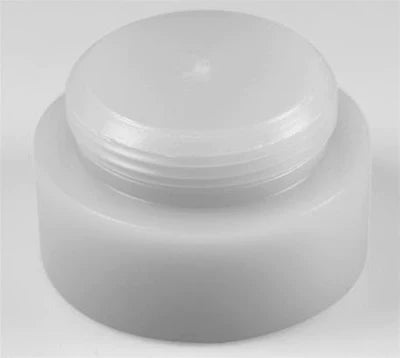The dental mallet is a small tool that dentists use to apply pressure on teeth and bones. It can be made out of stainless steel. The end of the mallet is blunt so it can be used to hit other objects. This makes it perfect for breaking things during procedures such as tooth extraction or root canal treatments.
Types of dental mallet:
- Dental Mallet, ML29.
- Surgical Dental Mallet, ML02.
- Surgical Dental Mini Mallet, ML20.
- Nylon End Dental Mallet, ML25.
Dental Mallet, ML29:
Surgical Dental Mallet, ML02:
Surgical Dental Mini Mallet, ML20:
The surgical dental mini mallet, ML20, is an ergonomically designed instrument that provides optimum comfort and control for the dentist. The mini mallet is perfect for use in oral surgery, implant placement, and other delicate procedures. With its lightweight design and durable construction, the mini mallet is a valuable addition to any dentist's toolkit.
Nylon End Dental Mallet, ML25:
Nylon Disc for Dental Mallet, ML25D:
What are the main benefits of using a dental Mallet?
The benefits of using a dental mallet are given below:
- Mallets can be used to create uniform tooth shapes.
- Mallets can help smooth out rough edges on teeth.
- Using a mallet can save time and effort when compared to other methods of shaping and contouring teeth.
- Using a dental mallet decreases the likelihood of injury to both the patient and the dentist.
- When using a dental mallet, the dentist has greater control over the shaping and contouring of the tooth.
Why is dental Mallet effective?
The main reason dental mallets are effective is because they help to shape and contour teeth. By using a variety of different mallet heads, dentists can create the desired results for their patients. Mallets also come in handy when working on difficult-to-reach areas of the mouth, such as wisdom teeth. In addition, dental mallets can be used to gently tap dental implants into place or remove them if necessary.
What are the precautions we need to take while using the dental Mallet?
Precautions we need to take while using the dental mallet:
- Always wear gloves when handling the mallet.
- Inspect the dental mallet regularly to make sure that it is not showing any signs of wear and tear.
- Get proper training before attempting to use a dental mallet.
- Take care not to damage other teeth when working with the dental mallet.
- Always sterilize the dental mallet before and after use.
How aggressive should a dentist be while using a dental Mallet?
The dentist should be relatively aggressive while using the dental mallet in order to ensure that the correct amount of pressure is being applied to the tooth. The level of aggressiveness will vary depending on the patient's individual circumstances. For example, if the teeth are particularly sensitive, the dentist may need to use less pressure. On the other hand, if the teeth are very tough, the dentist may need to use more pressure in order to break through the enamel. In any case, it is important for the dentist to carefully monitor the patient.
What types of patients would benefit from using a dental Mallet?
Many different types of patients can benefit from using a dental mallet. For example, patients with teeth that are difficult to align may find that using a mallet can help them get their teeth into the correct position. Finally, patients who are simply looking for a way to keep their teeth clean and free of plaque may also find that using a mallet is an effective way to do so. Ultimately, any patient who is interested in keeping their teeth healthy and free of cavities may find that using a dental mallet is a good option for them.
What are the main uses of dental Mallet?
The main uses of a dental mallet are for shaping and model making in dentistry. They are also used to tap implants into place, and for other various types of surgeries. Dental mallets come in different sizes and heads depending on their intended purpose. Dental mallets are used for dental restoration and orthodontics. In dental restoration, dental mallets are used to tap down loose fillings, and adjust dentures.
What factors should be noted while choosing a dental Mallet?
While choosing a dental mallet, you should consider the following factors:
- The size of the head.
- The type of handle.
- The weight.
- The material.
What is the working of the dental Mallet?
The working of the dental mallet is pretty simple. All you need to do is place the point of the mallet on the tooth that needs to be extracted and then tap it with a hammer. The force of the tap will cause the tooth to loosen and eventually fall out.
Why do we choose the dental Mallet?
A dental mallet is chosen because it is a non-vibratory tool that will not cause any damage to the teeth or surrounding tissues. It is also lightweight and easy to handle, making it an ideal choice for use in the dental office.
When should the dental Mallet be replaced?
It is recommended that a dental mallet should be replaced when it becomes blunt or if the head of the mallet becomes loose. A blunt dental mallet can cause damage to the teeth and gums, while a loose head can cause injury to the patient.
Review:
The dental mallet is a great tool for dentists. It is made of quality materials and it is easy to use. It allows dentists to apply force to teeth in a controlled manner, which is important for dental procedures. It would highly recommend this tool to any dentist looking for an efficient way to apply force to teeth.







